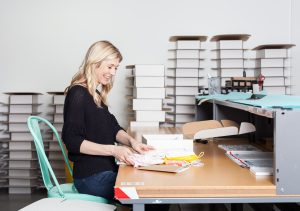In this new series, the Women in Retail Leadership Circle interview leaders that inspire us. This week features Marie Tillman, founder of Mac & Mia, a Chicago-based children’s apparel service. Tillman is also co-founder and chairman of the Pat Tillman Foundation, named for her late husband, the former NFL player who died in Afghanistan after enlisting in the U.S. Army. The nonprofit organization provides academic scholarships for veterans and their spouses.
Melissa Campanelli: Why did you decide to start Mac & Mia?
Marie Tillman: Mac & Mia was born out of the belief that shopping for kids should be convenient, but also fun and full of quality, unique pieces to fit their little personalities. As a working mom, I understand the struggle of trying to do it all. Kids, a career, a household … how do you keep it all running smoothly and not drive yourself crazy?
When my son Mac was born, I struggled with doing it all and looked everywhere for a helping hand. Grocery delivery and online everything became my go-tos, but shopping for the kids (we have five) was difficult. I wanted the convenience of delivery without the sameness of mainstream retailers or hours spent searching online for unique pieces. When my daughter came along two years later, I used my maternity leave to launch Mac & Mia. We now have a team focused on finding the best emerging and established brands, as well as delivering a personalized experience to busy families across the country.
MC: How does the shopping process on Mac & Mia work?
MT: Mac & Mia is an online children’s clothing service that provides unique and stylish kids clothes, handpicked by a personal stylist and delivered to your door.
- Take our style quiz online. Help us understand what you like and don’t like.
- Request a box. Receive six to eight pieces handpicked by your stylist. Shipping is free!
- Pay for what you keep. Keep the pieces you love, send the rest back in a pre-paid envelope. It’s easy!

MC: How do you lead and inspire your team each day?
MT: My leadership journey was somewhat accidental. After the death of my first husband, Pat, in Afghanistan in 2004, together with a group of friends and family, we started the Pat Tillman Foundation. Very quickly I was thrust into a leadership role and tasked not only with defining the vision and mission of the organization, but also executing on that mission. It wasn’t easy building the foundation, nor was it easy finding my voice and identity as its leader. I was fortunate to have some great mentors along the way. I’m proud of the work we’ve done to support over 500 Tillman scholars across the country with over $15 million in funding. I’ve learned so much during this journey, and one of the biggest lessons I take with me in my role as CEO at Mac & Mia is the need for great leaders to provide the vision for an organization. It’s a daily exercise providing motivation and vision for an organization so everyone is focused on a common goal.
MC: You have a great culture at Mac & Mia, one that supports working parents. For example, I know many members of your remote styling team are stay-at-home moms. Why is this important to your company?
MT: There’s so much going on now with remote workforces and flex schedules for employees. I read recently that around 31 percent of mothers leave the workforce, often after the birth of a second baby, and for an average of 2.2 years. I’ve seen these statistics play out with my own peer group where so many friends leave careers due to the lack of flexibility and challenges around the notion of “having it all.” I love that we’re able to offer an alternative for moms wanting to stay engaged with the workforce. Our stylist team is comprised of predominantly moms who work remote and can have flexibility over their schedules. They work closely with our customers to develop genuine relationships for a truly personalized customer experience.
MC: What are some strategies you can share with our readers around hiring?
MT: The No. 1 thing I look for when hiring is attitude and passion. We want people who are excited to be here and passionate about what we’re building.
Another important element is how people think and approach problems. Experience and education can get you far, but understanding how someone will problem solve is key. We move fast, so people need to be able to work independently and take on things that may be new or unfamiliar to them.





